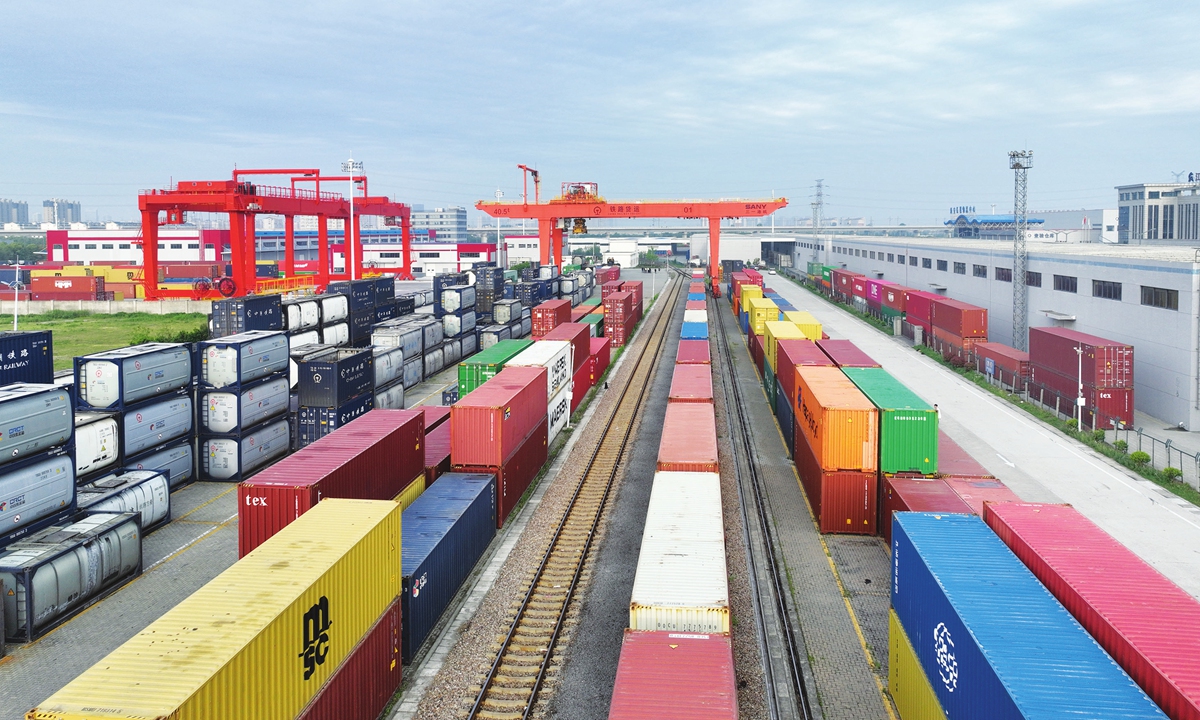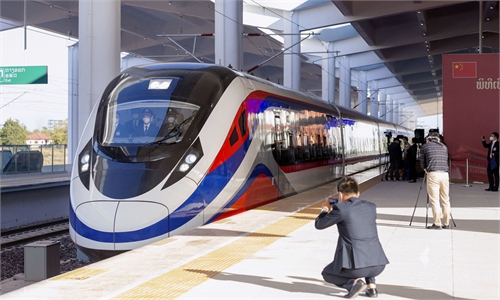

The first China-Laos freight train specially arranged for the transportation of fertilizer with 70 TEUs departs from Nanjing in East China's Jiangsu Province to Luang Prabang, Laos, on April 25, 2023. Photo: cnsphoto
The China-Laos Railway, after more than a year of successful operation, has offered a great example for good-willed cooperation on green development between China and Southeastern Asian countries under the great Belt and Road Initiative (BRI).
The railway has established a benchmark for green and sustainable development of infrastructure projects with the Association of Southeast Asian Nations (ASEAN) economies, said a report released by the Chongyang Institute for Financial Studies at the Renmin University of China (RDCY) at the BRI 10th anniversary forum held in Vientiane, the capital city of Laos.
Since its official opening in December 2021, the railway has provided an efficient and convenient land trade route. It has accelerated the transportation speed of goods, reduced delivering costs, and ultimately promoted bilateral trade growth.
As a low-carbon transportation line, the China-Laos Railway has lower carbon emissions and energy consumption compared to traditional road or air transportation, reducing negative environmental impact throughout the entire supply chain. At the same time, the operation of the railway could promote the popularization of clean energy, the report said.
Moreover, the project has attracted and catalyzed green investments, creating successful investment experiences for other green cooperation projects under the BRI. For example, the project adopted various investment approaches, including public, private, and cross-border financing measures.
Environmental boon
By employing mechanisms of benefit-sharing and risk-sharing, it has promoted investors to share in the resultant economic benefits, and encouraged them to assume corresponding risks and responsibilities, significantly enhancing project sustainability, the report said.
In the 18 months since its opening, the railway has shown a dynamic trend in passenger and cargo transportation volume, ferrying a total of 16.4 million passenger trips and 21 million tons of cargo.
Bilateral trade has rosy prospects with the promotion of the China-Laos railway which is expected to keep gaining steam along with the development of the BRI, Chanhphasouk Vidavong, director of Trade Policy Research Division of Institute for Industry and Commerce under the Laotian Ministry of Industry and Commerce, said at the forum on Wednesday.
The railway has created an engineering and economic miracle not only in Laos, but also in the entire ASEAN region. Also, the lives of the Laotian people have improved due to the BRI, which serves as the best embodiment of the China-Laos community with a shared future, said former Lao Deputy Prime Minister Somsavat Lengsavad at the forum.
As a prime example, the China-Laos Railway will become a bridge for China and ASEAN members to promote high-quality green development cooperation under the BRI in the future, the report said.
ASEAN needs $200 billion in green investment annually, while the funding available stands at yearly average of $40 billion. From 2016 to 2030, a total of approximately $3 trillion will be needed, which has highlighted the significant potential and strategic importance of China's active participation in the ASEAN green finance market, read the report.
As the "dual carbon" goals enter a substantive phase in China, the country's green investments under the BRI will align with the diverse green investment needs of the ASEAN, driving international cooperation in the field.
After initiating the "dual carbon" targets, China has since embarked on a self-driven green transformation and upgrade in domestic industries. In the meantime, it has actively promoted climate governance and international cooperation in green industries, Liu Jintao, an associate research fellow at the RDCY, told the Global Times.
Green paradigm
As a result, the country has steadily established the fundamental framework of a green "dual circulation" paradigm and emerged as a significant global leader in sustainable growth, Liu said. China has now developed advantages in green industrialization. Currently, the nation contributes to over half of the world's wind power generation and its solar panels account for 80 percent of global production.
Attracted by the BRI, an expanding number of nations have acknowledged the industrial and economic value that China's green investments could bring to local communities, Liu said.
The country has grown to be the world's largest green financing market, with the balance of domestic and foreign currency green loans having surpassed 22 trillion yuan ($3.05 trillion) as of end of 2022, and the balance of green bonds exceeding 1.5 trillion yuan.
"Moreover, China's commitment to and actions on climate goals have been acknowledged and lauded by the international community," Liu said.
Yet, some challenges remain in the cooperation between China and Southeastern Asian countries in the field, including meddling by the West, the report warned.
Achieving carbon neutrality and collaborating on climate governance involves the core interests of long-term sustainable development of each country, making it a significant international issue. Some Western countries may seek to force ASEAN countries to take sides in their competition with China, the report continued.
Most Southeast Asian countries are, in fact, developing economies with unfinished industrialization processes, which lack solid foundations for green and low-carbon transformation. While residents in Southeast Asia's tropical and coastal regions are affected by the fallout of climate change, it is necessary for the international community to provide more financial and technological support, Liu said.
"However, the promised climate assistance of $100 billion annually from developed countries to developing countries is yet to be materialized. It is necessary to be vigilant against falling into the trap of climate aid from the developed countries and guard against empty promises," Liu said.
It has, however, been proven feasible to collaboratively establishing a regional green investment and financing market, and drawing on China's advantages in green standards, and green financing instruments to undertake green cooperation in the region, he noted.
Liu added that the international community should pay attention to the unique challenges and needs that developing countries face in green and sustainable development and the West should cease attempts to slander the win-win cooperation between China and ASEAN.


